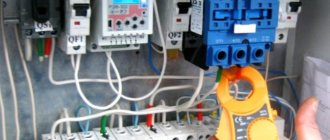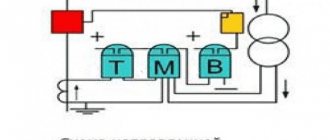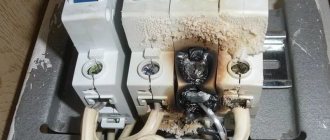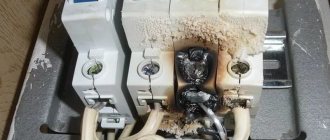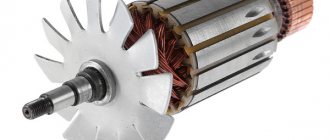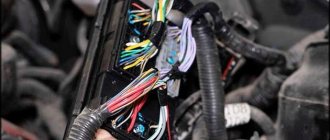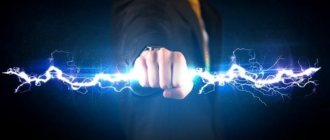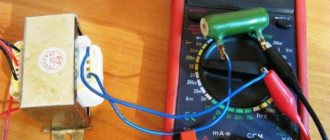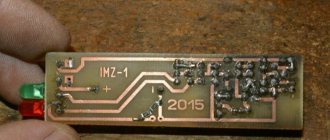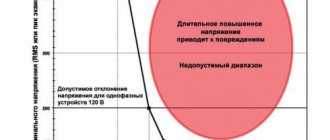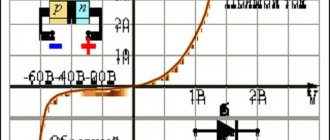What is a short circuit?
This term is usually used to refer to the state of a network in which electrical contact between points of an electrical circuit with different potentials, which is not provided for by normal operation, takes place.
Low resistance in the contact area causes a sharp increase in current strength, exceeding the permissible value. To understand the process, let's give a clear example. Let's say there is a 100 W incandescent lamp connected to a 220 V household network. Applying Ohm's Law, we calculate the current value for normal mode and short circuit, ignoring the resistance of the source and electrical wiring.
Electrical diagram of normal operation (a) and short circuit (b)
Under normal operation of the above circuit, the electric current will be 0.45 A (I = P/U = 100/220 ≈ 0.45), and the load resistance will be 489 Ohms (R = U/A = 220/0.45 ≈ 489).
Now let's consider the change in circuit parameters when a short circuit occurs. To do this, we close the circuit between points A and B and make a connection using a wire with a resistance of 0.01 Ohm. Taking into account the properties of electric current, it will choose the path with the least resistance, accordingly, Is will increase to 22000 A (I=U/R). Actually, for this reason the circuit is called short.
This example is greatly simplified; in reality, the fault current will not rise to 2.2 kA, since there will be a voltage drop across the consumer, according to Kirhoff’s second law: E = I * r + I * R, where I * r is the voltage at the power source, and I * R, respectively, on the consumer. Since R tends to zero when closed, the voltmeter in the circuit shown above will show a voltage drop.
Causes of the dangerous situation
An emergency situation and a short circuit cannot occur just like that.
In each specific case there are certain reasons and negative factors:
- High voltage level when closing. Usually occurs as a result of a sharp jump in which all permissible norms are exceeded. The probability of breakdown of insulation or the entire circuit becomes very high. Current leakage increases with a simultaneous increase in arc temperature. During a short circuit, high voltage always creates a short-term arc discharge.
- Old worn layers of insulation coating. Such situations most often occur when wiring has not been replaced for a long time. Weak insulation turns out to be the most susceptible to electrical breakdown, the reason for which is the exhaustion of its resource.
- External mechanical influences. The protective sheath of the conductors is gradually frayed, and the insulating coating is damaged. Wire strands are also susceptible to damage, causing not only short circuits, but also fires.
- Sometimes foreign objects - dust, debris, etc. - get into the electrical circuit. When they hit a conductor, they create their own additional circuit that can cause a short circuit current in the source.
- Lightning strikes that create high voltages that easily penetrate an entire electrical circuit or conductor insulation.
Why does a short circuit occur?
In order to understand why a short circuit occurs, you need to remember Ohm’s law for a section of a circuit - “The current strength in a section of a circuit is directly proportional to the voltage and inversely proportional to the electrical resistance in this section,” the formula is as follows:
I=U/R
where I is the current strength, U is the voltage on the circuit section, R is the resistance.
Any electrical appliance in an apartment that is plugged into an outlet is an active resistance (R - in the formula), you should know the voltage in the household electrical network - 220V-230V and it practically does not change. Accordingly, the higher the resistance of an electrical appliance (or material, conductor, etc.) connected to the network, the lower the current value, since the relationship between these quantities is inversely proportional.
Now imagine that we connect an electrical appliance to the network with virtually no resistance, let’s say its value is R = 0.05 Ohm, we assume that then the current will be according to Ohm’s law.
I=220V(U)/0.05(Ohm)=4400A
The result is a very high current; for comparison, a standard electrical outlet in our apartment can only withstand a current of 10-16A, but according to our calculations, it is 4.4 kA.
Modern copper wires used in wiring have such good electrical conductivity that their resistance, with a relatively short length, can be taken as zero. Accordingly, the direct connection of the phase and neutral wires can be compared to connecting an electrical appliance to the network with very low resistance. Most often, in everyday life, we are faced with this type of short circuit.
Of course, this is a very rough example, in real conditions, when calculating the current strength during a short circuit, you have to take into account much more indicators, such as: the resistance of the entire line of wires going to you, connections, additional network equipment and even the arc formed during a short circuit, as well as some others. Therefore, most often, the resistance will be higher than the 0.05 Ohm that we took in the calculation, but the general principle of the occurrence of a short circuit and its destructive effects is clear.
Single-phase short circuits
In practice, single-phase short circuits occur in most cases. In networks with an isolated neutral, when one phase is connected to ground, the mode is not a short circuit and the uninterrupted power supply is not disrupted, but it must be turned off, since it corresponds to an emergency condition. When one phase is short-circuited to ground in a given network, the voltages on the other two phases increase by 1.73 times, and the voltage at the zero point becomes equal to the phase voltage relative to ground.
It will be interesting➡ What is the coefficient of performance (efficiency) and how to calculate it using the formula
In networks with a solidly grounded neutral, when the wire is connected to the ground, a fuse burns or a circuit breaker trips, which disrupts the power supply, and if the fuse burns, the motor windings can be damaged when operating on two phases.
If in any part of the electrical wiring or electrical appliance (light bulb, iron, etc.) the insulation is broken and the phase wire touches the neutral wire, a short circuit will occur.
Since there is no load between the shorted wires, in other words, the electrical resistance of the contact point is practically zero, the current through the contact will begin to increase until the wires melt, which, in particular, can lead to a fire. Fuses are used to protect against short circuits.
A simple (in the form of a “plug”) fuse is a low-fusible insert included in the phase wire, which, when the current increases, will burn out and open the circuit long before more serious troubles occur. Structurally, the fuse is designed in such a way that this micro-disaster does not lead to damage to the fuse block. The little heroine who sacrificed herself is thrown out and replaced by the next one.
Short circuit current calculation
Short circuit voltage is the voltage at which an electric current equal to the rated current flows through the closed winding of the transformer.
The short-circuit voltage can be determined by the voltage drop across the transformer. This value characterizes the total resistance of the windings. The currents resulting from a short circuit significantly exceed the rated value for which the entire electrical circuit is designed. They can burn out weak points, destroy them and lead to fire.
To eliminate an emergency situation, specialists at the design stage begin to deal with the defect and calculate the theoretical possibility of the occurrence of large currents. Taking into account the calculated data, power elements and protective components of the circuits are selected. They also deal with large currents during equipment operation.
The calculation of single-phase and three-phase short-circuit current is carried out using Ohm's law, the impedance of the circuit, the power characteristics of the power and the structure of the electrical installation used. Accuracy may vary depending on the intended use of the instruments.
Basic concepts and calculation principle
The formula for calculating the short-circuit current itself is simple, it comes from Ohm’s law for a complete circuit and has the following form:
Iкз=Uф/Zф-о
Where:
- Uph - phase voltage of the network (230 Volts);
- Zph-o is the total resistance of the loop (circuit) phase-zero in Ohms.
What is a phase-zero loop (phase-zero)? This is an electrical circuit consisting of phase and neutral conductors, as well as the transformer windings to which they are connected.
In turn, the resistance of this electrical circuit is called the phase-zero loop resistance.
We recommend reading: ATS: design and principle of operation of the transfer system, use of automatic power switching
As you know, there are three types of resistance: active (R), reactive (X) and total (Z). To calculate the short circuit current, it is necessary to use the total resistance, which can be determined from the resistance triangle:
Note: The sum of the impedances of the neutral and phase conductors is called the impedance of the supply line.
It is quite difficult to calculate the exact resistance of the phase-zero loop, because its resistance is influenced by many different factors, starting with the transition resistance of contact connections and the resistance of the internal elements of protection devices, ending with the ambient temperature. Therefore, for practical calculations, simplified methods for calculating short-circuit currents are used, one of which is given below.
For reference: Short circuit current is determined by calculation, as a rule, only for new and reconstructed electrical installations at the stage of designing the electrical network and selecting its protection devices. In existing electrical installations, it is most advisable to determine the short-circuit current by carrying out appropriate measurements (by direct measurement of the short-circuit current, or by indirect measurement, i.e., measuring the resistance of the phase-to-zero loop and subsequent calculation of the short-circuit current).
Methodology for calculating short-circuit current
1) Determine the total resistance of the supply line up to the short circuit point:
Zl = √(R2l+X2l), Ohm
Where:
- Rl — Line resistance, Ohm;
- Xl — Line reactance, Ohm;
Note: The calculation is made for each section of the line with a different cross-section and/or conductor material, followed by the summation of the resistances of all sections (Zpl=Zl1+Zl2+…+Zln).
The active resistance of the line is determined by the formula:
Rl =Lfo*p/S, Ohm
Where:
- Lfo - Sum of the lengths of the phase and neutral conductors of the line, m;
- p - Specific resistance of the conductor (for aluminum - 0.028, for copper - 0.0175), Ohm* mm2/m;
- S - Conductor cross-section, mm2.
Note: the formula is given taking into account that the cross-sections and material of the phase and neutral conductors of the line are the same, otherwise the calculation must be performed using this formula for each of the conductors individually, followed by summing their resistances.
Line reactance is determined by the formula:
Chl =Lfo*0.6/1000, Ohm
2) Determine the resistance of the supply transformer
The resistance of a transformer depends on many factors such as the power, the design of the transformer and mainly the wiring diagram of its windings. For a simplified calculation, the transformer resistance for a single-phase short circuit (Ztr(1)) can be taken from the following table:
3) Calculate the short circuit current
The single-phase short circuit current is determined by the following formula:
Iкз=Uф/(Ztr(1)+Zpl), Ampere
Where:
- Uph - Phase voltage of the network in Volts (for 0.4 kV networks is taken equal to 230 Volts);
- Ztr(1) — Resistance of the supply transformer during a single-phase short circuit in Ohms (from the table above);
- Zpl - Total resistance of the supply line (phase-zero circuit) from the supply transformer to the short circuit point in Ohms.
Example of short-circuit current calculation
For example, take the following simplified single-line diagram:
- Determine the total resistance of the supply line to the point of short circuit
As can be seen from the diagram, there are three sections of the network in total; the resistance must be calculated for each separately, and then the calculated resistances of all sections must be added up.
- Section 1
Rl1 =Lfo*p/S=150*0.028/35=0.12 Ohm
Chl1 =Lfo*0.6/1000=150*0.6/1000=0.09 Ohm
Zl1 = √(R2l+X2l)=√(0.122+0.092)=0.15 Ohm
- Section 2
Rl2 =Lfo*p/S=20*0.028/16=0.035 Ohm
Chl2 =Lfo*0.6/1000=20*0.6/1000=0.012 Ohm
Zl2 = √(R2l+X2l)=√(0.0352+0.0122)=0.037 Ohm
- Section 3
Rl3 =Lfo*p/S=40*0.0175/2.5=0.28 Ohm
Chl3 =Lfo*0.6/1000=40*0.6/1000=0.024 Ohm
Zl3 = √(R2l+X2l)=√(0.282+0.0242)=0.281 Ohm
Thus, the total resistance of the supply line (phase-zero circuit) from the supply transformer to the short-circuit point will be:
Zpl=Zl1 +Zl2 +Zl3 =0.15+0.037+0.281=0.468 Ohm
- Determining the resistance of the transformer
As can be seen from the diagram, the power source is a 160 kVA transformer, with a “star-star” winding connection diagram with the neutral removed. We determine the resistance of the transformer according to the table above:
Ztr(1)=0.16 Ohm
- We calculate the short circuit current
Iкз=Uф/(Ztr(1)+Zpl)=230/(0.16+0.468)=366 Ampere
How a short circuit is formed
As we remember from the 8th grade physics textbook, Ohm’s law for a section of a circuit is determined by the formula:
Where
I – current strength in the circuit, A
U – voltage, V
R – resistance, Ohm
Let's look at this diagram
If we connect a table lamp EL to a current source Bat and close the switch SA, the tungsten filament of the lamp will begin to heat up under the thermal influence of the current. In this case, a significant part of the electrical energy is converted into light and heat.
Now let’s put an end to the lyrical digressions and connect the two wires that go to the light bulb through the thick wire AB
What happens next if we close the contacts of the SA key?
As a result, the current will flow along a shortened path, bypassing the load. The short path in this case is the AB wire. The resistance of wire AB is close to zero. As a result, our circuit is converted into a current divider. According to the current divider rule, if loads are connected in parallel, then a higher current will flow through the load with a lower resistance, and a lower current will flow through the load with a higher resistance. Since wire AB has almost zero resistance, a large current will flow through it, again according to Ohm’s law:
As I already said, in short circuit mode the current reaches critical values that exceed those permissible for a given circuit.
How to prevent short circuit
There is a short answer to this question: to prevent a short circuit from occurring, follow the rules for operating electrical appliances. The specific recommendations below will help prevent short circuits.
Do not turn on partially damaged appliances
If the cable in an iron or refrigerator is frayed and the inner shell is visible, do not turn it on until you have repaired it. First, carefully remove the top layer of insulation in the damaged area and inspect the external condition of the insulation. Wrap all damage and cracks tightly with electrical tape. Then put the top shell back and rewind it too.
The plug often needs to be replaced, for example if it is very loose or the housing is damaged. It is sold in any transition or store, so don’t delay your purchase.
Damage can occur not only on the power cord, but also inside. For example, if you turn on something and hear sparking inside. This already indicates a serious malfunction, even if the electrical equipment works, at first glance, normally. In this case, unplug it from the outlet and take it to a service center (or repair it yourself).
Remember that turning on a faulty electrical appliance often leads to a short circuit, which will destroy all wiring in the house and is likely to cause a fire. If you remain nearby, you risk serious injury.
Even if you have checked all the wiring and turn on only new, working equipment, this does not provide a 100% guarantee that an accident will not occur in your network. Therefore, always install high-quality circuit breakers and RCDs in the panel.
We recommend reading: How to determine phase and zero: with an indicator screwdriver, multimeter, visually
Use suitable circuit breakers
The recommendation primarily concerns household consumers: owners of apartments, houses, and dachas. Using so-called “bugs” instead of fuses, as well as installing unsuitable circuit breakers, increases the risk of cable heating and short circuits.
Example: the electricity supplier has agreed to install a 16A circuit breaker. This fuse is designed for the permitted power consumption and current. It trips when the current exceeds 16 amperes and protects the network from an accident. If you install a 40A “breaker” or “bug” in this network, the consumer will not suffer from frequent fuse trips. But the network will remain unprotected from abnormal loads. This increases the risk of cable damage and short circuits.
A “bug” is a homemade or self-modified fuse. Typically this is a fuse that uses a thick wire instead of a fuse.
Fuse with bug
Check cable functionality
Before installing wiring, check the cable for integrity of insulation and absence of short circuit. A cable with tape armor must be checked for a short to armor. This is easiest to do with a megohmmeter.
A megohmmeter will help identify a short circuit
Replace aluminum wiring with copper
With a smaller wire cross-section, copper conducts electricity better and can withstand greater loads. In addition, it withstands more mechanical bending and does not oxidize as quickly as aluminum.
New PUEs generally prohibit the installation of aluminum wiring in household networks, since it is potentially dangerous and less efficient in operation than copper.
In Soviet times, aluminum wiring was often used in residential buildings. If your apartment still enjoys such a “Soviet legacy”, think about it; its service life has probably expired long ago.
Don't ignore dust and moisture protection
When placing sockets, switches or electrical appliances in places of high humidity, take care of a high level of dust and moisture protection. For example, outdoors where precipitation, dew and fog are possible, it should be at least IP67. The minimum level for a bathroom is IP44, if there is a possibility of direct water splashes, then IP56 is better.
If water gets inside, the socket will begin to spark, the plastic casing will melt, and eventually a short circuit will occur. Therefore, always choose the optimal level of dust and moisture protection.
Do not operate electrical networks without grounding or zeroing.
Grounding and zeroing alone does not prevent a short circuit. But thanks to this protection, in the event of a short circuit, the current strength is instantly reduced to a level that is safe for humans and equipment.
In apartment buildings and private buildings, grounding is implemented so that in the event of a short circuit, circuit breakers are triggered. Therefore, it is enough for household consumers to use reliable fuses, as described above.
Choose a cable of sufficient cross-section
Before purchasing, be sure to calculate the likely maximum load on the line. The cross-section must be sufficient to safely pass current during peak load hours, for example, in winter when the heating is on or on weekends, when the maximum number of electrical consumers is working at home.
The optimal cross-section for socket groups is 2.5mm² and above, and for lighting 1.5mm² or 0.5mm² for LED. But it’s better to make accurate calculations of the maximum power and select the cross-section based on them.
Consider the electrical wiring diagram in the building and on the site during repairs
During repairs or excavation work on the site, it is important not to damage the wiring. Therefore, when drilling or tapping walls, it is important to check the area using a hidden wiring tester. And before carrying out excavation work, it is important to study the wiring diagram on the site.
How does a short circuit differ from an overload?
If the phase and neutral of the electrical network are connected under voltage to each other not through the consumer, but directly, then a short circuit will occur, abbreviated as short circuit. A short circuit is the connection of conductors of individual phases to each other or to the ground through a relatively low resistance, taken equal to zero in the case of a solid metal short circuit.
No network is designed to operate in this mode for long periods of time. However, this emergency mode sometimes occurs. Thus, a short circuit can occur due to a violation of the insulation of the electrical wiring or due to the accidental short circuit of opposite conductors with conductive parts of electrical equipment. The normal operation of the electrical network will be disrupted. To prevent this undesirable phenomenon, electricians use terminal blocks or simply isolate the connections.
It will be interesting➡ Kirchhoff's laws in simple words: definition for an electrical circuit
The problem with the short circuit mode is that at the moment of its occurrence, the current in the network increases many times (up to 20 times the nominal), which leads to the release of a huge amount of Joule heat (up to 400 times the norm), since the amount of heat released is proportional to the square of the current and resistance consumer.
Now imagine: the consumer resistance here is a fraction of an ohm of the wiring, and the current, as is known, the higher the lower the resistance. As a result, if the protective device does not immediately operate, excessive overheating of the wiring will occur, the wires will melt, the insulation will ignite, and a fire may occur in the room. In neighboring rooms supplied by the same network, the voltage will drop, and some electrical appliances may fail.
Important on the topic: How to ring a transistor.
A typical type of short circuit for residential apartments is a single-phase short circuit, when a phase closes to zero. For three-phase networks, for example in a workshop or garage, a three-phase or two-phase short circuit is possible (two phases between each other, three phases between each other, or several phases to zero). Three-phase equipment, such as an asynchronous motor or a three-phase transformer, is characterized by an interturn short circuit, when the turns are short-circuited inside the stator winding or inside the transformer winding, shunting the remaining working turns and thus disabling the device.
Or a short circuit may occur through the conductive body of the device. In general, conductive housings should be grounded in order to protect personnel from accidental electric shock, and wires in apartments should be those with non-flammable insulation. There is another type of emergency load mode of the electrical network associated with excess of normal current.
This is the so-called overload. Overloads sometimes occur in apartments, houses, and businesses. This is a dangerous mode, sometimes more dangerous than a short circuit. After all, a short circuit in an apartment can be stopped in the bud by an instantly triggered circuit breaker in the panel. But current overload is a more tricky case.
Switches for short circuit protection.
Imagine that you decided to plug a lot of electrical appliances into one single outlet through a tee and extension cords. What undesirable things could happen in this case? If the wiring core connected to the outlet is not designed for a current of more than 16 amperes, then when a load of more than 3500 watts is connected to such an outlet, overheating of the electrical wiring will begin, fraught with fire.
In general, the thermal effect on wire insulation sharply reduces its mechanical and dielectric properties. For example, if the conductivity of electrical cardboard (as an insulating material) at 20°C is taken as unity, then at temperatures of 30, 40 and 50°C it will increase by 4, 13 and 37 times, respectively.
And thermal aging of insulation most often occurs precisely because of overload of electrical networks with currents exceeding the long-term permissible for a given type and cross-section of conductors. It is also impossible to connect consumers of more than 2500 W to a socket on which 250 V 10 A is indicated, because the contacts may begin to overheat, leading to their accelerated oxidation. To protect against overloads in the apartment, as well as to instantly stop the short circuit mode, use circuit breakers.
What determines the voltage and current during a short circuit?
Above I said that a short circuit can occur at any point on the line. Let's figure out how the current and voltage will depend on the location of the short circuit.
A short circuit is a physical phenomenon. Short circuit current is a parameter of the power supply network, measured in amperes or kiloamperes (kA).
The German physicist Ohm has taught us since school years that voltage and current are determined through the resistance of the circuit:
Short circuit current, like any current, is also calculated according to Ohm's law and depends on the voltage and resistance in a given section of the circuit. Since the resistance of wires in real life is not only what the multimeter shows, but also the inductive component, we will write Ohm’s law for short-circuit current in a more general form:
In the numerator U is the rated voltage in the network (no-load voltage at the output of the transformer at the transformer substation). The number that is obtained in the calculations in the denominator is the total resistance of the circuit Z, on which the short-circuit current depends. Let's consider a single-phase power supply circuit for an apartment and a real case of a short circuit with a shorted hair dryer:
Short circuit at the end of the supply line (minimum short-circuit current)
The diagram shows the impedances of various sections of the supply network:
- Z1 – internal resistance of the transformer at the substation, taking into account the recalculated resistance of the high-voltage part,
- Z2 – cable line from the transformer substation to the distribution point (DP) of the apartment building,
- Z3 – cable line from the distribution point to the apartment panel,
- Z4 – cable from the panel to the socket in one of the rooms,
- Z5 – carrying from an outlet to a closed hair dryer.
We recommend reading: What is a voltage divider and where is it used?
The hair dryer burned out and caused a short circuit
Here's what a voltage level graph might look like in different areas - from the terminals of a transformer at a substation to a shorted hair dryer plug:
Voltage drop to zero as a result of a short circuit at the end of the line
The voltage drop is accompanied by the release of heat in all parts of the supply line. In powerful sections with a large cross-section of wires, the share of the “indoor” short-circuit current is negligible, so the drop there is small (sections with resistance Z1, Z2).
In connection with the voltage drop as a result of a short circuit, it can be noted that this will be noticeable on parallel loads connected, for example, to the same RP. In the event of a short circuit or severe overload of one of the consumers, the light bulbs in neighboring houses and entrances will begin to burn dimmer. Has it happened?
And here’s what the change in short-circuit current from the source to the fault point might look like:
Decrease in current when moving away from the power source
The typical value of the short-circuit current at the terminals of a transformer with a power of up to 1000 kVA, which is used to power urban consumers, is about 10 kA. But in the sockets of our apartments, the short-circuit current can be about 1000 A. In the private sector and rural areas, the value of the short-circuit current can be much less - up to 100 A.
Short circuit search methods
Finding the location of this phenomenon in advance is quite difficult. In most cases, neither specialists nor ordinary users care about it. However, this will help neutralize it in time, which will make it impossible for harmful consequences to occur. Thanks to timely response, financial resources and time are saved. There are several methods for determining a short circuit:
- visual inspection of the wiring (there should be no breaks or exposed wires);
- using a multimeter or megohmmeter;
- by sound;
- exception.
Wires that are part of a live cable may come into contact with each other. If they are exposed, then this is the obvious cause of the short circuit. Such damage is usually found in junction boxes and other power supply units (sockets, switches, etc.). Burnt cable insulation is an obvious place where a short circuit could potentially form.
The use of special instruments helps to measure the resistance value of the circuit. They contain 2 wires: one of them is connected to the phase, and the other to zero (hereinafter referred to as ground). If the device display shows 0, then the wiring integrity is normal, if any other value, the contacts are in contact. Please note that the multimeter voltage is quite small. It can be used to measure chains no more than 3 meters long.
Finding the location of a short circuit by sound is a popular method for determining this phenomenon. To do this, you need to listen carefully at all connections. A characteristic cracking sound will be heard at the point of contact. Sometimes there is a smell of burnt plastic and insulation. This method of finding short circuits should be used only as a last resort when other methods are unavailable.
It often happens that the culprit is a connected electrical appliance. Turning it on will immediately trip the fuse. This will lead to an immediate shutdown of the power supply to the area. You can find such a device by elimination, turning on all devices one by one.
Experts strongly recommend not to use outdated methods of searching for short circuits. In most cases, they do not show proper accuracy and efficiency. If there is a need to find a short circuit location, it is necessary to invite professionals who will use high-quality and accurate equipment.
Causes of short circuit
Now let's briefly look at the possible causes of short circuits.
Common causes of short circuits are as follows:
- outdated wiring;
- mechanical damage inside the circuit;
- improper organization of electrical wires;
- violation of the rules for operating an electrical appliance;
- uncontrolled increase in the power indicator of devices;
- non-compliance with construction standards.
How to prevent a short circuit
The easiest way is to follow the recommendations specified in the PUE - almost all entries in this book are preceded by some kind of accident or at least an emergency situation. Well, since most likely no one will learn the rules, you should at least be guided by common sense, which dictates the following:
- If the wiring is old, then replacing it is highly recommended. If for some reason this is not possible, then at a minimum, you need to inspect the contacts of the sockets and assess whether they require additional insulation.
- If the apartment is flooded by neighbors from above, then, even if nothing is short-circuited, this is a reason to reconsider the twisting of the wires in the distribution boxes - under the influence of moisture, the sticky side of the electrical tape loses its properties.
- You need to be careful when driving nails into walls - an unsuccessfully driven nail brings with it a lot of headaches in replacing the broken wire.
When carrying out major repairs, it is strongly recommended to draw up an electrical wiring plan, and if there are twisted wires in any place, then be sure to indicate it on the diagram - this is a potential “weak link”.
You can also simply take a photo of the wires before they are hidden in the wall.
- In the private sector, it is imperative to take additional measures to protect wiring from rats and mice - there are a fairly large number of ways to combat rodents found by home electricians - these can be metal corrugations, coating cables with mastic and other methods.
- If you had to plug a powerful device into the outlet, then it’s worth double-checking whether the contacts and the insulation condition are not burnt.
An example of searching for a short circuit with a special device is in the video:
What is the threat of short circuit?
A short circuit primarily poses a threat to human health and life. This is associated with a fire hazard: fire of wire insulation, ignition of surrounding objects, and the ability of the insulation to spread combustion. Also, a change in current strength can be detrimental to the devices and instruments used, leading to catastrophic consequences. A short circuit can cause economic loss. Therefore, it is important to use measures to prevent the occurrence of the phenomenon and resort to installing protection methods.
Danger and consequences
To understand the danger a short circuit poses, it is enough to learn about the possible consequences of a short circuit. To do this, let's move on to a short list compiled according to statistical data from Rostechnadzor:
- The occurrence of a fire at the point of mechanical contact between non-insulated elements of equipment or an electrical network often becomes the cause of a fire.
- A decrease in the voltage level of the electric current in the fault zone will cause a malfunction of the electrical equipment. You can learn more about the consequences of low voltage in one of the publications on our website.
- As can be seen from Table 1 above, the share of symmetrical short circuits (K(Z)) accounts for no more than 5%, this means that in all other cases you will have to deal with network asymmetry, better known as “phase imbalance”. We have already discussed the consequences of such a regime in an earlier publication.
- The occurrence of various system accidents causing the disconnection of consumers of the power system until the short circuit is eliminated.
Types of short circuit
Electricity is used everywhere in both the domestic and industrial sectors. To reduce the risk of a short circuit to a minimum, a number of measures and devices have been developed to provide protection against short circuits. However, in order to accurately understand in which case and which device to use, you need to know the types of circuits. The main ones are:
- in DC circuits;
- in AC circuits (between: phase and ground, two different phases, three phases, two different phases and ground, three phases and ground).
The share of single-phase short circuits is 65% of damage, 2 phases with earth - 20%, two-phase - 10%, three-phase - 5%. Complex types of damage often occur, accompanied by multiple asymmetries. This means a type of closure of various phases that occurs at several points at the same time.
Types of short circuits
Depending on the specific circumstances and components involved in this process, all emergency situations of this kind are conventionally divided into the following types of short circuits:
- Three-phase (No. 1 in the figure). In this case, all three phases are in contact with each other, without any distortions. The distribution of currents occurs symmetrically, so the current strength and short-circuit EMF are quite easy to calculate. The main danger of such a short circuit is thermal and electrodynamic effects, which significantly exceed the same factors in other cases. An additional ground fault does not have any effect on the overall process, which is typical for such a situation.
- Two-phase (No. 2). Such a closure, like all others, is called asymmetrical due to the processes occurring. As a result, they are accompanied by a mandatory voltage imbalance. In two-phase cable power lines, the process can easily turn into three-phase. This happens due to the high temperature at the fault point, under the influence of which the insulation of live parts is destroyed.
- Two phases are connected to ground (No. 3). The situation is typical for systems with a grounded neutral.
- One phase is shorted to ground (No. 4). It is considered the most common short circuit occurring in residential and industrial facilities.
- Short circuit of two phases to ground (No. 5). Each of them closes separately, without contacting each other. Typically, this situation occurs in a circuit where there is a grounded neutral.
Use of this phenomenon
This phenomenon has found its application in arc welding, the operating principle of which is based on the interaction of a rod with a metal surface. The surface is heated to the melting temperature, due to which a new strong connection appears, i.e. the welding electrode is closed with the grounding circuit.
Such short circuit modes operate for a short period of time. At the time of welding, a non-standard current charge arises at the junction of the rod and the surface, due to which a large amount of heat is released. It is enough to melt metal and create a weld.
Short circuits are also used in the field of industrial automation; with its help, information systems are created that reflect the parameters of current signal transmission.
Useful short circuit is used in electrodynamic sensors. For example, in induction vibrometers, seismic receivers. A short circuit makes it possible to further reduce the number of oscillations of the moving system.
Short-circuit mode can be used when combining stages in electronics, when the output of the first active component operates in short-circuit mode.
Useful short notice
The current arising due to such a phenomenon can bring not only destruction, but also benefit. There are a number of equipment that operate under conditions of increased current. A classic example of such devices is electric arc welding. Its operation is due to the connection of the welding electrode and the ground loop.
Under significant overloads, the functioning of such devices is short-lived. It is provided by a high-power welding transformer. In the place where the 2 electrodes come into contact, a fairly significant current is generated. This leads to the release of a large amount of thermal energy, which is sufficient to melt the metal in the contact area. This process ensures welding operation. The seam is neat, durable and strong.
Preventive measures to prevent short circuits
Precautionary measures and preventive measures greatly help prevent short circuits.
The most important of them are the following:
Before finding a short circuit in the wiring, you should pay attention to noticeable sparking or cracking in the outlet and switches, accompanied by the smell of burnt plastic. These are the factors that most often lead to emergency conditions.
In such cases, it is imperative to replace the faulty installation products. Before laying new wires, it is necessary to calculate in advance the power of consumers that will be used in this network. Correctly selected cross-section protects cables from unnecessary overloads. During installation, the wiring should not be twisted. The cables are laid parallel, leaving free space between them. When performing repair work involving drilling walls, it is necessary to clarify in advance the location of the cable lines. Installing automatic protection means will allow you to avoid negative consequences by disconnecting the line at the time of a short circuit. At least 2-3 times a year, carry out routine inspections of switches, sockets, junction boxes where wires come from and powerful equipment. Wiring with aluminum conductors should be removed and replaced whenever possible, since this material, when heated, increases the resistance of the circuit, causing increased heating, short circuiting and melting of cable lines. When searching for a short circuit, all actions with wiring and electrical devices should be performed in strict compliance with safety precautions. By following the recommendations of specialists and strictly following the procedure, it is quite possible not only to independently detect an accident, but also to correct all its consequences.
Electrical problems are a common cause of breakdowns of electrical appliances. One of the common negative phenomena is a short circuit. It is dangerous not only for equipment, but also for the house itself, as it can lead to fire. You can deal with short circuits using fuses and circuit breakers in the active circuit. But in the case of a de-energized wire or device, finding a short circuit becomes more difficult. There are different ways to detect and fix a network defect.
Prevention of short circuits
Taking preventive actions is safer, more reliable and cheaper than restoring wiring after a short circuit. Sockets need to be checked periodically. If they start to spark, they need to be repaired or replaced. If the wiring has been partially replaced, the reliability of the connection points and the integrity of the insulating layer should be checked.
Light sources, lighting network and power cables should be checked every few months. A short circuit may occur over time. It can be detected by changes in the color of devices or their melting. The apartment must have automatic switches. Powerful electrical appliances are equipped with separate protective equipment that should operate in an emergency.
When installing electrical wiring yourself, it is important to correctly calculate the cable cross-section. If it is not able to withstand the power of all connected devices, an overload will occur, leading to a short circuit. Cables should not be laid closely together - this may damage the protective layer. Also, when connecting, you need to choose the right way to create a contact and purchase the necessary equipment in advance. Do not connect wires by twisting.
If you need to drill into a wall, you should check the place with a homemade metal detector or study the electrical wiring diagram. This way you can detect a hidden wiring cable that a technician could accidentally damage.
What are the types
Short circuit. Everyone has heard this phrase. Many have seen the inscription “Do not short-circuit!” Often, when an electrical appliance breaks down, they say: “It’s short!” And despite the negative connotation of these words, professionals know that a short circuit is not a sad death sentence. Sometimes it is pointless to fight a short circuit (SC), and sometimes it is fundamentally impossible. This article will answer the most important questions: what is a short circuit and what types of short circuits are found in technology.
Let's begin to look at these issues from an unusual angle - we will find out in which cases short circuits are inevitable and where they do not play the role of damage. Let's take an ordinary metal wire at both ends. Let's connect the ends together. The wire is short-circuited - a short circuit has occurred. But since there are no sources of electrical energy or load in the circuit, such a short circuit does not cause any harm. In some areas of electrical engineering, the short circuit that we have considered plays into our hands, for example, in electrical devices and electrical machines.
Let's take a look at a single-phase relay or starter, the design of which includes a magnetic system with moving parts - an electromagnet that attracts an armature. Due to the constantly changing polarity of the current flowing in the windings of the electromagnet, its magnetic flux periodically becomes zero, which causes the armature to rattle, vibrations and a characteristic hum, familiar to all electricians, appear. To get rid of this phenomenon, a short-circuited turn - a ring or rectangle made of copper or aluminum - is attached to the end of the electromagnet core or armature.
Due to the phenomenon of electromagnetic induction, a current is created in the coil, creating its own magnetic flux, compensating for the loss of the main magnetic flux created by the electromagnet, which leads to a decrease or disappearance of vibrations that destroy the structure.
A short circuit in the rotor of an asynchronous electric motor also plays a role. Due to the interaction of the magnetic field created by the stator windings with the squirrel-cage rotor, according to the already mentioned law, currents appear in the rotor, creating their own field, which causes the rotor to rotate
Of course, it is important to properly design an electric motor or electrical apparatus so that the currents flowing in short-circuited elements do not lead to overheating and damage to the insulation of the main windings
Socket fire
Similarly, the concept of "short circuit" is used in relation to transformers. People who are in one way or another connected with the energy industry know that one of the most important characteristics of a transformer is the short-circuit voltage, VSC, measured as a percentage. Let's take a transformer. We short-circuit one of its windings, say, low voltage (LV), with an ammeter, the resistance of which, as is known, is taken equal to zero. We connect the high voltage winding (HV) to a voltage source. We increase the voltage on the HV winding until the current in the LV winding becomes equal to the rated one, and fix this voltage.
We divide it by the rated voltage of the higher side, multiply by 100%, and get USC. This value characterizes the power loss in the transformer and its resistance, which determines the short circuit current leading to damage. Let's finally talk about short circuits that have negative consequences. Such short circuits occur when current from the power source does not flow through the load, but only through wires that have negligible resistance. For example, a three-phase cable is powered by a transformer, and with one careless movement of the excavator bucket it is damaged - two phases are short-circuited through the bucket. Such a short circuit is called two-phase. Other short circuits are called similarly based on the number of closed phases.
A single-phase earth fault in networks with an isolated neutral is not short, but can pose a threat to the lives of living beings. A short circuit in which the transition resistance is zero is called metallic - for example, with a bolted or welded connection. Short-circuit currents, depending on the voltage and type of damage, can reach thousands and hundreds of thousands of amperes, leading to fires and colossal electrodynamic forces that “twist” tires and wires. Protection against short circuits can be carried out by circuit breakers or fuses, and in high-voltage networks - by means of relay protection and automation.
Protection of the power supply from short circuit.
Measures to prevent short circuits
At the dawn of the development of electrical engineering, fuses appeared. The principle of operation of such protection is very simple: under the influence of the thermal effect of the current, the fuse is destroyed, thereby breaking the circuit. Fuses are most often used in household electrical networks and household electrical appliances, electrical equipment of vehicles and industrial electrical equipment up to 1000 V. They are also found in circuits with high-voltage equipment.
These are the fuses used in circuits with low currents
these are the fuses you see in cars
But these large fuses are used in industry, and they are already designed for very high current values
Circuit breakers equipped with electromagnetic and/or thermal sensors have a more complex design. Below in the photo is a single-phase circuit breaker, and on the right is a three-phase one
Their operating principle is based on opening the circuit when the permissible current values are exceeded.
In everyday life, we most often come across the following electrical protection devices:
- Fuses (also used in household electrical appliances).
- Circuit breakers.
- Surge Protectors.
- Residual current devices.
All of the above protective equipment refers to secondary protection devices operating on the inertial principle. Automatic protective devices operating on an adaptive principle are most often installed at the input of household electrical networks. Such devices can be seen near the electricity meters of apartments, cottages, and offices.
In high-voltage networks, protection is often provided by:
- Relay protection devices and other disconnecting equipment.
- Step-down transformers.
- Parallelization of circuits.
- Current-limiting reactors.
Most short circuits can be avoided if the main causes of their occurrence are eliminated: timely repair or replacement of worn-out equipment, and elimination of harmful human influences. Avoid incorrect actions during installation and repair work, comply with SNIPs and safety regulations.
Consequences and protection
The biggest trouble that can arise during a short circuit is the outbreak of a fire. The resulting excess heat causes the insulation and nearby combustible substances to ignite. In addition, during a breakdown, an electric arc occurs, which is an open source of fire. At the same time, it can ignite nearby objects.
If a person enters the zone of action of the circuit, he is subjected to a high-current shock. This leads to the release of heat by the body and subsequent combustion of the body.
Less significant consequences include the occurrence of a large electric field and electromagnetic shock, which negatively affect electronic components and radio equipment units, as well as electric motors. The appearance of a short circuit leads to phase imbalance in the electrical network, which causes a voltage surge in it, and this leads to breakdowns of the power supplies of electrical devices connected to it.
To prevent consequences when designing electrical systems, special devices and protection measures are used. Such measures include:
- periodic testing of insulation of equipment and power lines;
- the use of equipment or electrical wiring with an increased protection class in potentially hazardous places, for example, the use of high-quality dielectrics or flame-retardant double insulation;
- installation of fuses that blow when the current reaches a dangerous value;
- use of lightning protection, automatic and differential switches, voltage control devices.
Reasons for appearance
When a contact is formed between two flows of charges, a huge current arises, which is characterized by a short circuit. Since this sharp increase in energy occurs due to the appearance of a shock electric pulse, then, according to the Joule-Lenz law, the resulting power has a high degree of heat release.
The reason for this phenomenon is the violation of the insulating properties of the conductors. This can happen due to natural wear and tear or emergency situations in the operation of electrical equipment. In practice, this means direct contact between the neutral and phase wires.
But the wires do not necessarily have to touch each other. An instantaneous increase in current strength also occurs if a conducting body or medium with negligible resistance appears between them, for example, a conducting object, water or moist air. This situation is called a breakdown. The following reasons for the occurrence of short circuits can be identified:
Overvoltage. When the physical parameters of the power line are exceeded, when a large current flows through the conductor, its resistance turns out to be large for it, so intense heat generation occurs. The conductor heats up, transferring heat to the insulating layer, which cracks and collapses. The appearance of high voltage can be caused by both natural phenomena (lightning strike) and errors in the operation of electrical appliances or energy sources. Natural aging of insulation. Any insulation has its own resource, which is reduced when it is in an aggressive environment, for example, due to temperature changes. Mechanical damage: abrasion, damage during construction work, the result of rodents. Installation error
Careless handling of live parts of equipment, violations in cable laying (bending at an acute angle, crossing wires). Incorrect connection of electrical equipment or cables. Occurs due to human actions
This may be due to unsuccessful repairs, an error in connecting wires or power lines, or the use of broken devices.
